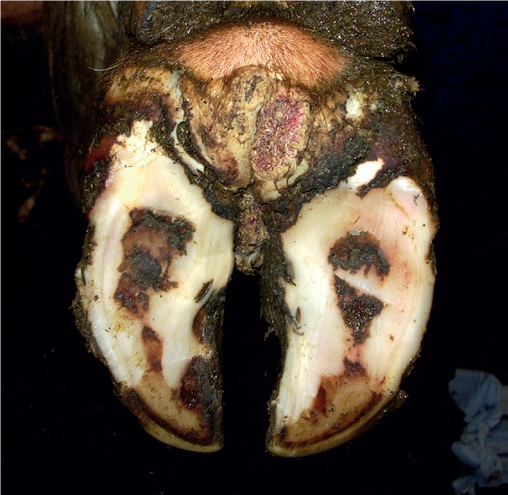Housing has begun on most farms across the country, which is when farmers often sees issues, such as digital dermatitis, appear.
Mortellaro, digital dermatitis, or Italian footrot as it is also known, is a stubborn hoof disease that can occur on all cattle farms.
Once the disease appears on a farm it is difficult, if not impossible to completely remove it.
It is most often seen in cattle that are housed, as it is easier for the bacteria to spread and multiply in these conditions.
Cause
Digital dermatitis usually presents as a lesion on the claw skin of the hoof, located between where both the claws merge.
The disease will appear as a red (strawberry-like) lesion that is very painful, and will often have a bad smell.

Mortellaro disease is caused by a mixture of bacteria, including:
- Bacteroides nodosus;
- Treponemes;
- Fusobacteria necrophorum;
- Anaerobic bacteria.
The environment in which the cows live is a major factor in whether or not cows are affected by the disease.
The disease is more commonly seen in housed herds with poor hygiene and wet conditions.
If the disease comes onto a farm it can be easily spread through bacteria in the manure.
So, it is important that scrapers run in the shed regularly and that any build up of excess manure is removed.
There are several other factors that aid in the transmission of the disease between cows.
For example, cows that suffer or have suffered from metabolic disorders (negative energy) and irregular hoof trimming can have a higher risk of contracting the disease.
Digital dermatitis
As prevention is better than cure, farmers should be aware of the herd health status of any animals that are purchased in.
Foot bathing during the housed period can also help to prevent issues, and this should be done in line with the manufacturer’s recommendations.
If a large number of cows are entering the footbath, farmers should consider emptying and refilling the bath to ensure each cow gets sufficient contact with the solution. Any excess manure or bedding material from cow’s feet should also be removed to increase effectiveness.
Farmers should also void overcrowding in sheds, complete regular mobility scoring and have cow regularly hoof paired.
If lesions appear on cows, copper sulphate is commonly used in hoof baths to treat the issue.
The use of salicylic acid can also be effective at controlling mortellaro. Salicylic acid has a low pH, which makes it a bactericide.
Salicylic acid comes in a powder and can be placed directly on the lesion, using a bandage to keep it in place for a number of days.
